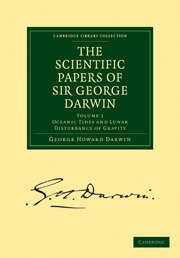Book contents
- Frontmatter
- PREFACE
- Contents
- Chronological List of Papers with References to the Volumes in which they probably will be contained
- PART I OCEANIC TIDES
- ART. 1 The Harmonic Analysis of Tidal Observations
- ART. 2 On the Periods Chosen for Harmonic Analysis, and a Comparison with the Older Methods by means of Hour-angles and Declinations
- ART. 3 Datum Levels: the Treatment of a Short Series of Tidal Observations and on Tidal Prediction
- ART. 4 A General Article on the Tides
- ART. 5 On the Harmonic Analysis of Tidal Observations of High and Low Water
- ART. 6 On an Apparatus for Facilitating the Reduction of Tidal Observations
- ART. 7 On Tidal Prediction
- ART. 8 On the Correction to the Equilibrium Theory of Tides for the Continents
- ART. 9 Attempted Evaluation of the Rigidity of the Earth from the Tides of Long Period
- ART. 10 Dynamical Theory of the Tides
- ART. 11 On the Dynamical Theory of the Tides of Long Period
- ART. 12 On the Antarctic Tidal Observations of the ‘Discovery’
- PART II THE LUNAR DISTURBANCE OF GRAVITY
- INDEX
- Plate section
ART. 6 - On an Apparatus for Facilitating the Reduction of Tidal Observations
Published online by Cambridge University Press: 07 September 2010
- Frontmatter
- PREFACE
- Contents
- Chronological List of Papers with References to the Volumes in which they probably will be contained
- PART I OCEANIC TIDES
- ART. 1 The Harmonic Analysis of Tidal Observations
- ART. 2 On the Periods Chosen for Harmonic Analysis, and a Comparison with the Older Methods by means of Hour-angles and Declinations
- ART. 3 Datum Levels: the Treatment of a Short Series of Tidal Observations and on Tidal Prediction
- ART. 4 A General Article on the Tides
- ART. 5 On the Harmonic Analysis of Tidal Observations of High and Low Water
- ART. 6 On an Apparatus for Facilitating the Reduction of Tidal Observations
- ART. 7 On Tidal Prediction
- ART. 8 On the Correction to the Equilibrium Theory of Tides for the Continents
- ART. 9 Attempted Evaluation of the Rigidity of the Earth from the Tides of Long Period
- ART. 10 Dynamical Theory of the Tides
- ART. 11 On the Dynamical Theory of the Tides of Long Period
- ART. 12 On the Antarctic Tidal Observations of the ‘Discovery’
- PART II THE LUNAR DISTURBANCE OF GRAVITY
- INDEX
- Plate section
Summary
Introduction.
The tidal oscillation of the ocean may be represented as the sum of a number of simple harmonic waves which go through their periods approximately once, twice, thrice, four times in a mean solar day. But these simple harmonic waves may be regarded as being rigorously diurnal, semi-diurnal, ter-diurnal, and so forth, if the length of the day referred to be adapted to suit the particular wave under consideration. The idea of a series of special scales of time is thus introduced, each time-scale being appropriate to a special tide. For example, the mean interval between successive culminations of the moon is 24h 50m, and this interval may be described as the mean lunar day. Now there is a series of tides, bearing the initials M1, M2, M3, M4, &c., which go through their periods rigorously once, twice, thrice, four times, &c., in a mean lunar day. The solar tides, S, proceed according to mean solar time; but, besides mean lunar and mean solar times, there are special time scales appropriate to the larger (N) and smaller (L) lunar elliptic tides, to the evectional (ν), to the diurnal (K1) and semi-diurnal (K2) luni-solar tides, to the lunar diurnal (O), &c.
The process of reduction consists of the determination of the mean height of the water at each of 24 special hours, and subsequent harmonic analysis. The means are taken over such periods of time that the influence of all the tides governed by other special times is eliminated.
- Type
- Chapter
- Information
- The Scientific Papers of Sir George DarwinOceanic Tides and Lunar Disturbance of Gravity, pp. 216 - 257Publisher: Cambridge University PressPrint publication year: 2009First published in: 1907



